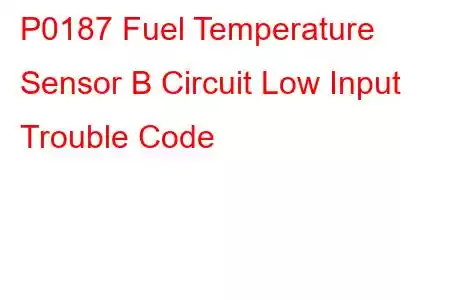P0187 Fuel Temperature Sensor B Circuit Low Input
OBD-II Trouble Code Technical Description
Fuel Temperature Sensor B Circuit Low Input
What does that mean?
This diagnostic trouble code (DTC) is a generic powertrain code, which means that it applies to OBD-II equipped vehicles (Nissan, Ford, Fiat, Chevrolet, Toyota, Dodge, etc.). Although generic, the specific repair steps may vary depending on make/model.
In my experience, a stored code P0187 means that the powertrain control module (PCM) has detected a voltage signal from the fuel temperature sensor (or circuit) that is lower than expected. The fuel temperature sensors (with which I have dealt) have been integrated into the fuel composition sensor. "B" refers to an area of circuitry as opposed to a particular circuit or component.
The fuel composition sensor is designed to provide the PCM with an accurate fuel composition and fuel temperature analysis. Usually small in size, the fuel composition sensor is a computerized device found in-line between the fuel tank and the fuel rail.
The percentage of ethanol, water, and other contaminants in fuel are monitored by the fuel composition sensor as they pass through. Square waveform voltage representations are input to the PCM according to the level of contamination in the fuel. Shorter waveform frequency indicates a high percentages of fuel contamination. Waveform frequency could also be described as the vertical posting of the pattern.
The percentage of ethanol present in the fuel is typically categorized independently of other contaminants. Flex fuel vehicles can function efficiently even if fuel composition levels are as high as eighty-five-percent ethanol. Fuel temperature is computed as pulse width or the horizontal portion of the waveform. The wider the pulse width signal, the higher the temperature of the fuel passing through the fuel composition sensor. Most systems utilize a pulse width that varies between one and five-milliseconds (hundredths-of-a-second).
If the fuel temperature is not within a specified range, or if the fuel temperature is much lower than ambient temperature, a P0187 code will be stored and a malfunction indicator lamp (MIL) may be illuminated. Some vehicles will require multiple ignition cycles (with a failure) for MIL illumination.
Code Severity & Symptoms
Because flex fuel vehicles use fuel temperature to calculate fuel delivery strategy, this code should be treated as severe.
Symptoms of a P0187 code may include:
Possible MIL illumination There may be no obvious symptoms Other fuel composition codes may be presentCauses
Potential causes for this code to set are:
Faulty intake air temperature sensor A bad ambient temperature sensor Defective fuel temperature/composition sensor Open, shorted, or damaged wiring or connectors PCM or a PCM programing errorDiagnostic and Repair Procedures
A good starting point is always to check for technical service bulletins (TSB) for your particular vehicle. Your issue may be a known issue with a known fix put out by the manufacturer and can save you time and money during diagnosis.
In my opinion, the most complete tool for diagnosing a code P0187 is a diagnostic scanner with an integrated DVOM and an oscilloscope. An infrared thermometer and a vehicle information source (like All Data DIY) will also be useful.
An excellent starting point for any diagnosis is a visual inspection of all related wiring harnesses and connectors. Damaged or burnt wiring and connectors will need to be repaired or replaced. Once that is completed, you will want to clear the codes and retest the system. I have discovered from experience that even the OBD II readiness mode can help when multiple failure cycles are required for MIL illumination. It is simple to complete your repairs and clear the codes, then drive
Read: 47


